Physical Address
304 North Cardinal St.
Dorchester Center, MA 02124
The ankle is a highly specialized joint that allows us to propel ourselves in an efficient manner during multiple activities. The mortise shape facilitates transmission of 1.5 times the body weight when walking, and up to four times the body weight when running. Activities such as standing and walking and all athletic ability require stable, strong foot and ankle function to provide a stable platform for propulsion and yet allow adaptation for uneven surfaces and changes in speed and direction. This chapter covers the pathology, history, examination, investigation, treatment, and rehabilitation of ligament injuries of the foot and ankle.
Ankle sprains are one of the most common soft tissue injuries affecting athletes of all sporting levels and account for nearly 40% of sports injuries. Athletes in sports such as basketball, football/soccer, running, and volleyball have a higher incidence of ankle injuries.
The lateral ligament complex, consisting of the anterior talofibular ligament (ATFL), the posterior talofibular ligament (PTFL) and calcaneofibular ligament (CFL), is most commonly involved. The injury results from an inverted, plantar-flexed foot with an internally rotated hindfoot and an externally rotated leg. The medial side is rarely injured. These injuries can lead to chronic instability, which can cause significant public health issues in persons who do not participate in sports, and can have a profound effect with regard to the time it takes to return to sports in athletes. The incidence of chronic ankle instability after an acute ankle sprain has been reported to be between 5% and 70%.
Lateral ankle sprains comprise 85% of all ankle sprains. The most commonly injured structure is the ATFL ( Fig. 117.1 ). The strain in the ATFL increases as the ankle moves from dorsiflexion into plantar flexion. The ATFL demonstrates lower maximal load and energy to failure values under tensile stress compared with the PTFL, CFL, and anterior inferior tibiofibular ligament (AITFL), which may explain why the ATFL is the most frequently injured lateral ligament. The CFL is the second most common ligament to be injured, followed by the PTFL. Injury of the ATFL causes increased internal rotation of the hindfoot and stress on the remaining ligaments.
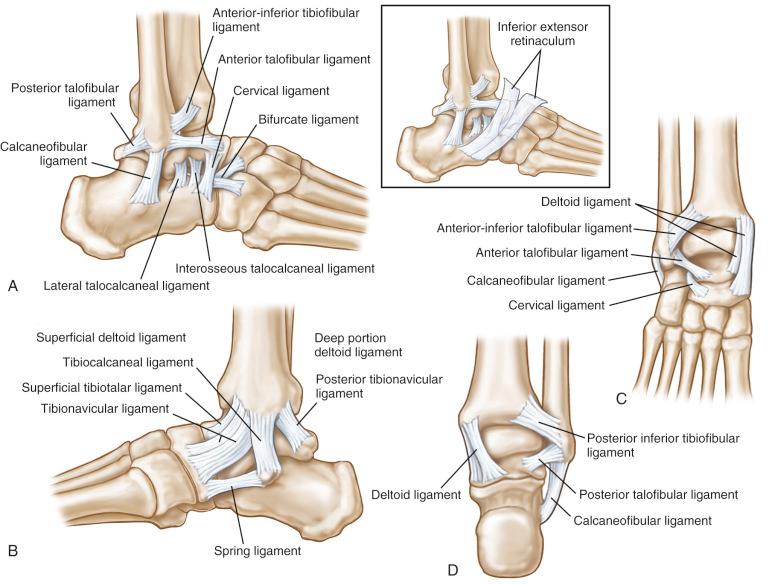
Risk factors for lateral ankle sprains include a previous sprain, greater height and weight, limb dominance, pes cavus, a larger foot size, the use of inappropriate footwear, generalized joint laxity, ankle flexor strength asymmetry, decreased slow eccentric inversion strength, increased fast concentric plantarflexion strength, reduced hip extension strength, and reduced muscle reaction time due to neuromuscular control.
Persons with acute injuries have a preceding traumatic event that involves an inversion mechanism of injury with associated swelling, ecchymosis, and difficulty with weight bearing. The findings are frequently the same in persons with acute and chronic injuries. However, persons with chronic injuries have a history of recurrent instability, which frequently occurs with less severe trauma. One must be careful to inquire about whether the patient has adapted his or her lifestyle to minimize injury, such as via cessation of regular sporting activities, avoidance of uneven ground, and not wearing high-heeled shoes. In persons with chronic instability, the overall severity of the injury is less and therefore patients tend to have less swelling and bruising, together with a diminished effect on the ability to fully bear weight after each episode.
Palpation should be specific with regard to tenderness over the course of the ligamentous structures, namely the ATFL, CFL, and AITFL, to aid in the diagnosis. Bony structures including the distal fibula, anterior process of the calcaneus, lateral process of the talus, and base of the fifth metatarsal should be palpated specifically to assess for possible osseous injuries. One should also specify if tenderness of the peroneal myotendinous units is present from just superior to the metaphyseal flare of the distal fibula to the insertion point at the base of the fifth metatarsal. Tenderness to palpation within the ankle joint itself may suggest the presence of synovitis, occult fracture, or osteochondral lesion. Although rare, dislocation of the hindfoot may occur, and limited passive motion should raise suspicion of this injury.
The anterior drawer test should be performed, along with talar tilt stress testing. The anterior drawer test assesses the integrity of the ATFL, whereas the talar stress test assesses the CFL, although it is sometimes difficult to identify specific ligaments from the examination of an acute injury, and the stress test is not very accurate.
The anterior drawer test is performed with the patient seated and the distal tibia stabilized with one hand of the examiner while the other hand grasps the heel and the foot is anteriorly translated. The ankle is positioned into plantarflexion while testing. The presence of anterior subluxation of the foot should be compared to the contralateral side. In persons with a complete ATFL tear, the talus subluxates anteriorly and a dimple forms on the anterolateral joint area (the “sulcus sign”) ( Fig. 117.2 ).
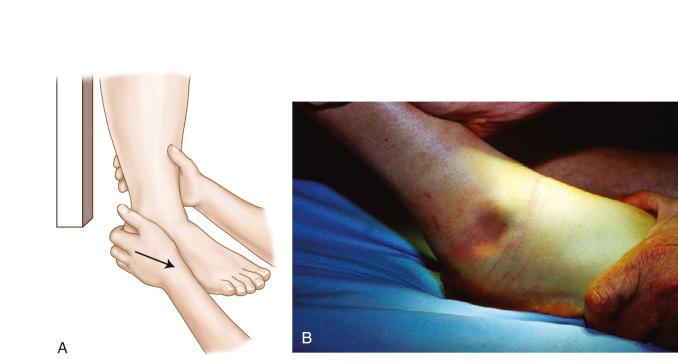
In isolated lateral ligament injuries, the medial-sided static stabilizers may prevent anterior translation during the anterior drawer test. For this reason a modification of the anterior drawer test, called the anterolateral drawer test, was developed. Similar to the anterior drawer test, one hand stabilizes the distal tibia and the other provides an anterior translational force. However, in this test the examiner does not constrain rotation of the talus and also directly palpates movement on the talus by placing a thumb along the lateral joint line between the talus and the distal fibula. This allows the examiner to directly assess translation and rotation of the talus.
In the acute setting, if it is difficult to examine the patient because of pain, infiltration of a local anesthetic and reexamination of the patient provides a more accurate test result for the anterior drawer test. However, it is more common in our practice to reexamine the patient a few days after the injury to avoid use of this invasive maneuver.
The talar tilt test is performed with the patient seated and the leg secured with the examiner's hand while the heel is grasped with the opposite hand and an inversion force is administered to cause talar tilt ( Fig. 117.3 ). Results are compared with those of the other side to assess differences in the tilt. The CFL is tested in neutral, whereas the ATFL is tested in plantar flexion, but once again this testing can be difficult to perform because the contribution of the subtalar joint sometimes can cause false-positive results.
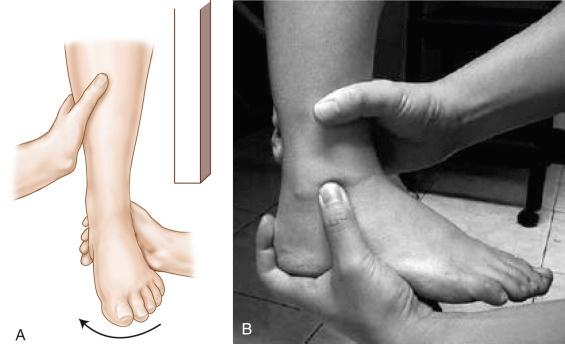
The examination is completed with checking of proprioception and joint hyperlaxity by calculating the Beighton score as shown in Table 117.1 . A score of 4 or higher is indicative of hyperlaxity.
| Testing | Points |
|---|---|
| Able to extend the little finger beyond 90 degrees | 1 point for each side (maximum: 2) |
| Able to bend the thumb and touch the volar forearm | 1 point for each side (maximum: 2) |
| Able to hyperextend the elbow beyond 10 degrees | 1 point for each side (maximum: 2) |
| Able to hyperextend the knee beyond 10 degrees | 1 point for each side (maximum: 2) |
| Able to lean forward and touch the ground with the knee straight | 1 point |
Radiographs to assess ligamentous injuries include standard weight-bearing anteroposterior (AP), lateral, and mortise views, as well as anterior drawer and talar tilt stress views, which can be obtained either manually or mechanically. The anterior drawer should measure less than 10 mm or within 3 to 5 mm of the opposite side. The talar tilt can range from 5 to 23 degrees, although the literature suggests that an absolute value of more than 10 degrees or more than 5 degrees when compared with the other side could be diagnostic. The degree of tilt is calculated by measuring the difference in angle between the distal tibial articular surface and the dome of the talus ( Fig. 117.4 ).
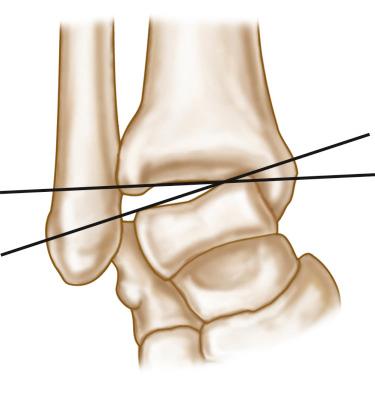
Magnetic resonance imaging (MRI) is the most accurate noninvasive modality; however, it is often positive for ATFL tears even in asymptomatic individuals. Therefore it is not usually required in the setting of a routine ankle sprain and should be reserved for suspicion of a syndesmotic injury, osteochondral defect, or peroneal tendon injury, or after failure of conservative management.
Multiple classifications and grading of ankle sprains exist, although none is superior. Maffulli classified them as grades I to III, but for sports injuries, Malliaropoulus further subdivided these grades to take into account the anterior drawer radiographs. The classification is shown in Table 117.2 . This grading is performed after 48 hours of rest and treatment with ice, compression, and elevation (RICE), together with gentle early range-of-motion (ROM) exercises.
| Grade | I | II | III |
|---|---|---|---|
| Injured structures | Partial | ATFL | ATFL and CFL |
| Decrease in range of movement | <5 | 5–10 | >10 |
| Edema | ≤0.5 cm | 0.5–2 cm | >2 cm |
| Stress radiographs | Normal | Normal | >3 mm laxity |
One must be mindful of associated injuries that can be seen in the setting of acute ankle sprains. These include but are not limited to fractures of the lateral malleolus, lateral talar process, os trigonum, cuboid, and fifth metatarsal, as well as peroneal tendon tears/subluxations, intra-articular osteochondral lesions of the talus or tibia, medial ankle sprains, and syndesmotic injuries. Patient history, physical examination, and imaging should be scrutinized to correctly diagnose these injuries in this setting.
Prevention is better than cure, but evidence supporting the use of proprioception exercises to prevent first-time sprains is limited, and no evidence exists to support the use of braces for the prevention of first-time sprains. The natural history of ankle sprains is that by 2 weeks after the injury, most patients experience rapid improvement of their pain, followed by a further 2 weeks when the pain subsides much more slowly. Rates of reinjury can range between 3% and 54%; this can be as high as 29% in athletes, based on the severity of the injury.
At 1 year, most patients have been noted to have some residual symptoms with pain and instability. Long-term follow-up at 3 years has revealed that as many as 34% of patients have had a repeat sprain, and 36% to 85% have had a full recovery. Therefore the appropriate treatment of sprains is imperative to guide early recovery and facilitate the prevention of future sprains.
The initial treatment of any acute sprain includes RICE, early ROM, progressive weight bearing, and physiotherapy. Treatment modalities include nonoperative and operative ones; the former involving casting, bracing, and early functional rehabilitation. The treatments depend on the severity of the injury and the patient's choice; however, multiple studies have demonstrated that nonoperative management is as successful as operative treatment in the acute setting. Presently, no evidence exists to support one treatment regimen over another.
The CAST trial showed that casting relieves pain in the initial period and is as effective as an Aircast splint (DJO Incorporated, Vista, CA), but it is better than Tubigrip (i.e., an elastic bandage) alone. Casting is usually implemented for 3 weeks followed by 12 weeks of proprioceptive rehabilitation. Complications, such as deep vein thrombosis, have been reported, and most studies have shown that functional management is the nonsurgical treatment of choice and that casting is not routinely used.
Functional management is classified as an early mobilization program with use of bracing and early rehabilitation. Multiple studies indicate that functional management of these injuries is recommended in contrast to other conservative treatment modalities such as immobilization. Authors of multiple articles and reviews have all come to the same conclusion. The purpose of rehabilitation exercise is to improve muscle strength, range of movement, and sensorimotor control, which are commonly impaired after an ankle sprain.
In most studies, functional treatment involved RICE for 48 hours followed by early supervised mobilization under the guidance of a physical therapist and progression to full weight bearing. Early isometric muscle strengthening may be initiated within a week, progressing to isokinetic strengthening after 1 week based on the patient's ability to tolerate the treatment. Furthermore, proprioception and peroneal strengthening begun be instituted concomitantly. As pain subsides, the therapy should be gradually expanded to include muscle strength and endurance exercises. Some series include adjuvants, such as cryotherapy, although no definite evidence has demonstrated their effectiveness. The use of braces or aids to support the ankle is recommended in functional treatment, and has been proved to decrease the rate of reinjury. Numerous ankle braces are available; we recommend using braces that lace up and have a strap that “locks” the ankle to prevent inversion, which could injure the healing of laterally based ligaments. Functional treatment should be performed for a minimum of 6 weeks.
Operative treatment is reserved for persons for whom conservative treatment has failed, where the primary complaint is chronic instability. Operative intervention is typically not indicated for acute instability events. Isolated ankle pain, without persistent instability should prompt further investigation. It is important to identify the quality of the rehabilitation the patient is undergoing. If it is deemed to be insufficiently robust or if the patient has had issues with compliance, he or she should be referred for physical therapy. The aim of the program is to improve strength and speed of firing of the peronei, as well as proprioception. We have found it helpful to refer patients to physical therapists who specialize in the treatment of foot and ankle disorders. The incidence of patients who have residual functional instability ranges from 5% to 70%. For patients with persistent ankle instability and/or ankle pain despite adequate functional rehabilitation, further imaging (i.e., an MRI) should be obtained.
Two forms of surgical treatment can be performed: anatomic and nonanatomic reconstructions. Anatomic repairs are more commonly performed in primary surgery. The seminal work on these repairs was carried out by Broström. He described an end-to-end repair or an advancement of the torn end of the ATFL into the distal anterior fibula ( Fig. 117.5 ). A total of 72% of patients were asymptomatic at 2.9 years, with 82% of those examined having a normal examination. Gould et al. described a modification of this technique, with excision of part of the scarred ATFL, ligament repair, and reinforcement with a ligamentous flap and the inferior extensor retinaculum ( Fig. 117.6 ). Excellent results were again achieved. Karlsson et al. described a further modification in which both the ATFL and CFL were advanced into a bony trough in the fibula together with reinforcement from a periosteal flap.
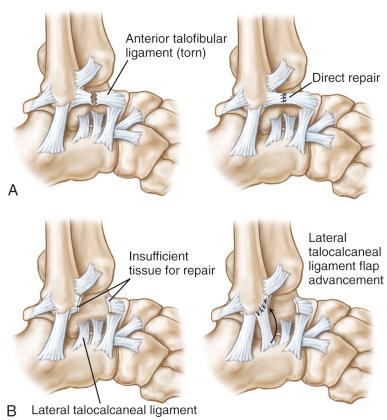
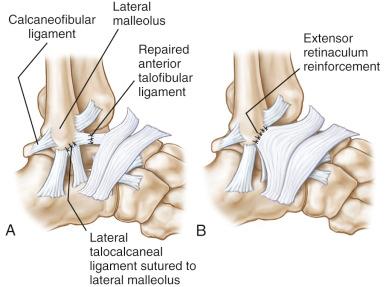
The use of a synthetic tape has been reported as a method to augment the Broströmrepair. Direct suture repair or the use of suture anchors alone has been shown to have a significantly inferior strength to the intact ATFL in a cadaveric model. The use of a synthetic tape (Fibertape; Arthrex Inc., Munich, Germany) to augment the repair can produce an initial construct that is at least as strong as the native ATFL, and can potentially allow a quicker recovery time.
Some authors have advocated the simultaneous use of arthroscopy, which allows full evaluation of the ankle joint and treatment of any other pathologic conditions that are found, such as loose bodies, soft tissue or bony impingement, and osteochondral defects. Although proponents of routine arthroscopy have demonstrated the presence of intra-articular pathologic features in a high percentage of patients, no clear evidence is available to indicate that routine arthroscopy affords a superior clinical result. The best indication for arthroscopy is the presence of ankle pain in addition to instability, or the presence of radiographic intra-articular pathologic conditions.
More recently, authors have advocated performing the ligamentous repair arthroscopically as well. Proponents of arthroscopic repair believe it has quicker recovery, decreased morbidity, and the ability to address intra-articular pathology with the same approach. A recent systematic review stated that both open and arthroscopically repaired ankles did well, based on patient satisfaction and American Orthopedic Foot and Ankle scores (AOFAS), although with a 15% surgical complication rate versus 8% in the open group. The most common complication in the arthroscopic group was superficial peroneal nerve neuritis, but this did not impact the patient satisfaction score. However, another systematic review from the same year stated there was insufficient evidence to make a high-grade recommendation for minimally invasive surgery for chronic ankle instability.
Nonanatomic repairs include the Evans procedure and the Watson-Jones procedure, in which the peroneus brevis tendon is transferred to act as a lateral tie bar to prevent instability and inversion. Chrisman and Snook described using a split peroneus brevis transfer along a more anatomic course to recreate the ATFL and CFL. Although good results were achieved—even at 10 years—moderate restriction in subtalar movement was still present. Ligamentous reconstructions should be reserved for revision cases given the restriction of physiologic movement and are not recommended for use as the index procedure. Many authors have described free tendon grafts with use of the fascia lata, semitendinosus, and gracilis; however, these grafts are best used in cases of revision or ligamentous laxity given the excellent results achieved with primary repair.
The patient is positioned supine with the leg placed in an ankle distractor. Arthroscopy is performed with use of standard anteromedial and anterolateral portals. Any incidental pathology is then treated arthroscopically.
The patient is then placed in a lateral position. A longitudinal incision is performed over the distal fibula and the soft tissues distal to it. The subcutaneous tissues are dissected from the lateral ligament complex. Careful inspection for any branches of the superficial peroneal nerve should be performed. Care is taken to preserve the inferior extensor retinaculum for the later Gould modification.
A U -shaped incision is made in the lateral ligament complex 0.5 cm distal to the fibula. The incision extends from just superior to the origin of the anterior talofibular ligament (ATFL) to just posterior to the origin of the calcaneofibular ligament (CFL).
A subperiosteal flap is raised off the fibula for approximately 1.5 cm. Rongeurs are used to remove the lateral and distal cortex ( Fig. 117.7 ). A suture anchor is placed at each of the positions of the origin of the ATFL and CFL.
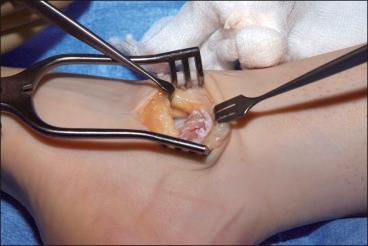
The sutures are then used to draw the distal flap onto the distal fibula, and they are tied off. The edge of this distal flap is then sutured to the base of the subperiosteal flap. The subperiosteal flap is then sutured distally to lateral soft tissues to act as a double-breasted reinforcement ( Fig. 117.8 ).
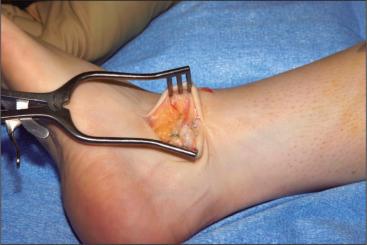
As an alternative to the use of suture anchors, a pants-over-vest technique is also very effective. The ATFL and CFL are transected 1 mm distal to the tip of the fibula. Bleeding of the cancellous bone of the distal cortex of the fibula is created with a rongeur. In this case, no subperiosteal proximal flap is created. The distal flap is then secured to the proximal soft tissue in a pants-over-vest fashion, taking care to perform an adequate imbrication to decrease the laxity; typically, two or three knots are required. The suture is begun on the distal flap, which allows the knot to be placed distally and away from the skin, and is then reinforced with a figure of 8, number 0 absorbable suture after completion of the pants-over-vest imbrication.
The extensor retinaculum is then identified and sutured to the reconstruction and the periosteum of the fibula, with the hindfoot and ankle held in a neutral position and dorsiflexion.
The wound is closed in layers. The leg is placed into a below-knee backslab cast in dorsiflexion and eversion.
The patient wears a splint and is non–weight bearing for 2 weeks. At this stage the sutures are removed and the patient is allowed to bear weight in a locked ROM walker boot.
At 4 weeks the ROM walker is unlocked and physical therapy is begun. For the next 2 weeks this therapy consists of ankle ROM exercises that are isolated to dorsiflexion and plantar flexion only, and swelling management.
At 6 weeks the patient is weaned into a semirigid functional brace. The intensity of physical therapy can be increased, with more robust ROM exercises (except forced inversion), early cardiovascular work, ankle-strengthening exercises, and proprioception exercises. Usually by 9 weeks the patient is being weaned out of the brace and is starting more sport-specific exercises, with progression to return to activity. The rehabilitation regime is obviously altered if other significant pathologic conditions were present in the ankle and addressed arthroscopically (e.g., an osteochondral defect).
In isolated lateral ankle sprains without instability, the vast majority of athletes are able to return to their previous level of play without significant time missed from sport. In a large epidemiologic study, Roos et al. found that there were almost 2500 ankle sprains amongst all NCAA sports over a 5-year period. Among those, 44% were able to return to their sport within 24 hours while only 3.6% required more than 3 weeks before returning. Maffulli et al. reported long-term outcomes of 42 athletes who underwent Broström repair for chronic lateral ankle instability. Sport at the preinjury level was still being practiced by 58% of the patients; 16% had changed to lower level sports, but were still active; and 26% had abandoned sport, but were still active. White et al. reported their experience with 42 professional athletes who underwent modified Broström repair. The indication for surgery was confirmed as acute grade III lateral ligament injury on MRI and instability on physical examination. Those with isolated ATFL and CFL injuries returned to training and sport at an average of 63 and 77 days, respectively. Those who had concomitant injuries returned to training and sport at 86 and 105 days, respectively. No patient had developed recurrent instability at 2 years, and all had returned to their preinjury level of professional sport.
Patients can have persistent pain and can have recurrent instability. With persistent long-term significant instability, the risk of posttraumatic osteoarthritis is undoubtedly increased. Most studies have shown that a small chance of recurrent instability exists in the long term. Our preferred method for dealing with cases of long-term instability is a nonanatomic lateral ligament reconstruction (i.e., Chrisman Snook).
Medial-sided ankle sprains, typically involve the deltoid ligament. They are quite uncommon and represent 4% to 5% of all ankle sprains.
The deltoid ligament is made up of the superficial and deep layers. The superficial layer originates from the superficial margin of the anterior part of the medial malleolus and attaches to the dorsal talus, navicular, and sustentaculum. The deep deltoid layer is made up of two parts—the deep anterior and deep posterior tibiotalar ligaments—which arise from the deep margin of the posterior colliculus and attach to the medial talus while blending with the medial capsule of the ankle joint. The deep deltoid resists posterior and lateral translation in addition to valgus angulation of the talus. The superficial structures of the deltoid complex resist external rotation of the talus relative to the tibia and valgus stress. The flexor retinaculum and the posterior tibial tendon sheath also contribute to the medial ligament complex stability.
Medial sprains are graded I for a ligament stretch injury, II for a partial tear, and III for a complete tear. Hintermann developed an anatomical classification based on whether the injury was a proximal avulsion or tear (grade I), midsubstance (grade II), or a distal avulsion or tear (grade III).
The deltoid ligament injury occurs when the hindfoot is in valgus and the forefoot is everted. The main risk factor for this type of injury is being a male athlete, with a possible link to pes planus deformity. These injuries tend to be relatively high-impact injuries as opposed to simple “giving way” because of the relative strength and surface area of this ligament, as well as the higher inherent osseous stability of the ankle joint on the medial side.
A patient with an acute injury presents with medial-sided pain and swelling with ecchymosis. The patient may report hearing a “pop” on the medial part of the ankle before the onset of pain and usually has difficulty with weight bearing. Repeated episodes of giving way are uncommon with chronic injuries. Patients with chronic injuries tend to have residual pain together with a lack of trust in the ankle or a sense that “it just doesn't feel right.”
After an appropriate focused physical examination is performed, the patient should be asked to lower himself or herself to a squatting position with the feet flat on the floor. In more significant cases of deltoid insufficiency (usually chronic cases), the medial malleolus becomes overtly prominent compared with the other ankle (a positive medial malleolar pointing sign). It should also be noted whether pes planovalgus is present.
Examination of the superficial deltoid is performed with the patient seated with mild ankle plantar flexion. The heel is cupped in the examiner's hand and brought forward while the tibia is stabilized with the opposite hand. In the case of superficial deltoid insufficiency, enhanced external rotation of the talus is observed in comparison with the contralateral side. In acute superficial deltoid ligament injuries, the anterior portion of the medial malleolus is normally painful to palpation, but this sign may be absent in athletes with chronic instability.
The deep deltoid ligament is assessed by examining the posterior translation of the talus from the tibia, which is best done with the patient prone with the legs hanging off the table. The degree of translation is compared with the other side.
Muscle function should be assessed. The main muscle to be tested is the tibialis posterior muscle. Patients should be asked to perform the double-heel raise test. The heel should smoothly swing from a valgus position to around 10 degrees of varus. The patient also should be asked to perform the single-leg raise test (except in the most acute settings). The patient should be able to perform this test with equal numbers and to an equal height on both legs.
If a valgus, pronated deformity of the foot corrects with single-heel raising, this finding indicates that the patient has a purely ligamentous injury (deltoid and spring ligament) with sparing of the tibialis posterior.
Radiographs to assess ligamental injuries include standard weight-bearing AP, lateral, and mortise views. An AP hindfoot alignment view (Salzmann or Cobey view) is also indicated. Translational deformities can be assessed from the radiographs ( Figs. 117.9 and 117.10 ).
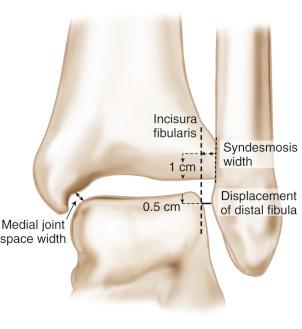
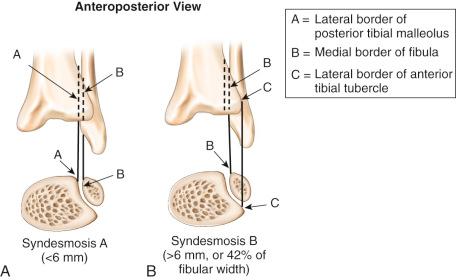
Stress radiographs under fluoroscopy have some use, particularly with the valgus stress test on an AP film bilaterally. A finding of more than 2 to 3 degrees of valgus is considered positive. Widening of the medial clear space by 6 mm on AP/mortise radiographs of the affected ankle is also suggestive of a medial injury.
An MRI can be helpful to evaluate the deltoid ligaments in detail. However, the position of the foot may influence the visualization of the relevant anatomy because the tibionavicular and anterior tibiotalar parts are best seen with the foot in plantar flexion, whereas the tibiocalcaneal and posterior tibiotalar parts are best seen in dorsiflexion.
The primary decision is whether the ligaments have discontinuity, because this factor has the largest influence on potential treatments. One must ensure that the syndesmosis, spring ligament, and tibialis posterior are intact. Although clinical acumen is pivotal in this decision, further imaging is essential when a partial or complete tear of the deltoid ligament is suspected. Normally, operative treatment is indicated only with failure of conservative treatment unless additional pathologic conditions need to be addressed concomitantly.
Strains can be treated with a semirigid brace that allows ankle plantar flexion and dorsiflexion but prevents inversion and eversion. Elevation and cold therapy are also indicated for the first week. A structural rehabilitation program is indicated and should initially focus on proprioception and maintenance of ROM. Return to sport is achieved in a graduated fashion as dictated by symptoms, but normally occurs within 3 weeks, with the use of a laced ankle brace for another 3 weeks.
An MRI scan should be performed to see if any evidence exists of an avulsion or complete intrasubstance tear of the deltoid, as well as any of the other aforementioned pathologic conditions. If complete insufficiency of the deltoid is suspected, an examination with the use of an anesthetic should be performed. Surgical repair is appropriate in the setting of documented instability.
If conservative treatment is indicated, initial immobilization is used to promote anatomic healing followed by physical therapy. Our preference is to initially treat patients in a locked ROM walker with an orthotic to support the medial longitudinal arch. The patient can bear weight as tolerated but must keep the boot on at all times except for purposes of hygiene. At 4 to 6 weeks the boot can be unlocked from 5 degrees dorsiflexion to 30 degrees plantar flexion to commence early mobilization. At 6 weeks the boot is completely unlocked and can be removed during physical therapy for ROM, proprioception, and ankle and inversion strength exercises. The patient is gradually weaned out of the boot into a functional ankle brace and undergoes a graduated return to sport-specific exercises with return to play (RTP) in a brace for a further 6 weeks.
Surgical treatment is reserved for those with documented instability or failure of conservative management. This involves either deltoid ligament repair or reconstruction if there is insufficient residual deltoid tissue. Nonunited avulsion fragments or heterotopic ossification can produce localized osseous impingement at the medial gutter. They can also produce a local prominence that can rub against footwear. It is prudent to obtain a preoperative MRI to check for a medial osteochondral defect whose symptoms can be masked by the presence of these fragments. These can be removed either through a deltoid-splitting incision or, for larger areas of ossification, by detaching the deltoid and re-attaching using suture anchors.
Surgical repair or reconstruction an acute deltoid ligament is uncommon; however, currently, it may be more routinely performed in the setting of ankle fractures with documented syndesmotic injury. In high-level athletes, MRI findings of a complete superficial and deep deltoid disruption, operative management can be considered. Given the paucity of literature on this injury, the decision in this patient population is based on the discussion between the surgeon and the player, weighing the benefit of a quicker RTP against those of wound complications and potential stiffness.
It is difficult to compare results in patients undergoing deltoid repair versus reconstruction because the pathologic entities are often very different. An adequate amount of deltoid remaining for repair is often the result of chronic instability, and when there is very little repairable tissue it is often the result of an end-stage flatfoot deformity. Therefore reconstruction techniques are out of the scope of this text.
If the ankle is unstable upon examination with use of an anesthetic, then surgical exploration can be indicated.
A medial longitudinal incision is performed from the medial malleolar metaphyseal flare down to the level of the talonavicular joint. The subcutaneous tissues are dissected off the deltoid ligament with careful inspection for any branches of the saphenous nerve in the superior margins of the wound.
If a superior avulsion is present, the torn ends of the ligament are dissected free. The cortex is removed with the use of rongeurs. One to three suture anchors (depending on strands of suture and size of tear) are then used to reattach the ligament. Alternatively, bone tunnels can be used to anchor the ligament.
If an intrasubstance tear is present, the subperiosteal flap should be raised and suture anchors used as in the surgical technique for lateral ligament insufficiency.
The wound is closed in layers. The patient's ankle is placed in a backslab in dorsiflexion and inversion. The postoperative regimen is similar to that for conservative treatment once the patient progresses to a locked ROM walker with an orthotic at 2 weeks.
In a prospective series of 52 patients with chronic anterior deltoid incompetence, pain in the medial gutter was found in all ankles (100%), pain along the posterior tibial tendon was found in 14 ankles (27%), and pain along the anterior border of the lateral malleolus was found in 13 ankles (25%). Repair of the deltoid ligament was performed in all 52 patients, repair of the spring ligament was performed in 13 patients (24%), repair of the lateral ligaments was performed in 40 patients (77%), and an additional calcaneal-lengthening osteotomy was performed in 14 patients (27%). At a mean follow-up of 4.4 years (range: 2.0 to 6.6 years), the AOFAS hindfoot score had improved from 42.9 points preoperatively to 91.6 points. The clinical result was considered good to excellent in 46 cases (90%), fair in four cases (8%), and poor in one case (2%).
Two possible local complications can arise from isolated deltoid injuries. Nonunited avulsion fragments or heterotopic ossification can produce localized osseous impingement at the medial gutter. They can also produce a local prominence that can rub against footwear. It is prudent to obtain a preoperative MRI scan to check for a medial talar osteochondral defect—the symptoms of which can be masked by the presence of these fragments. These fragments can be removed either through a deltoid-splitting incision or, for larger areas of ossification, by detaching the deltoid and reattaching it with suture anchors or bone tunnels ( Figs. 117.11 and 117.12 ).
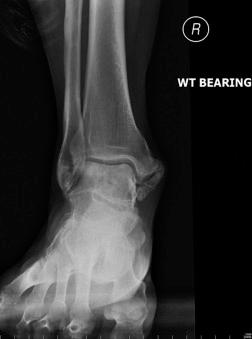
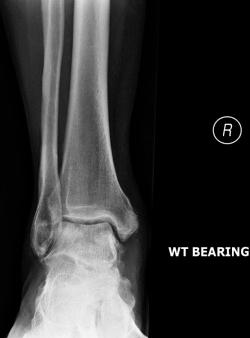
Chronic instability is the second complication and is most commonly due to insufficiency of the superficial deltoid. Hintermann et al. described three types of this instability. Type I is due to a chronic avulsion from the medial malleolus, and type II is a chronic intrasubstance tear. They are treated as outlined in the section on acute injuries. Type III lesions are from the distal insertion of the deltoid. These lesions are repaired with nonabsorbable sutures into the spring ligament, as well as a suture anchor into the superior edge of the navicular tuberosity if additional insufficiency of the tibionavicular part of the superficial deltoid is present. With use of this treatment algorithm, the authors managed to achieve a 90% rate of excellent results at 4 years.
Chronic instability of the deep deltoid ligament is an extremely challenging condition. Many different choices of graft and graft fixation have been attempted with equivocal results.
Become a Clinical Tree membership for Full access and enjoy Unlimited articles
If you are a member. Log in here